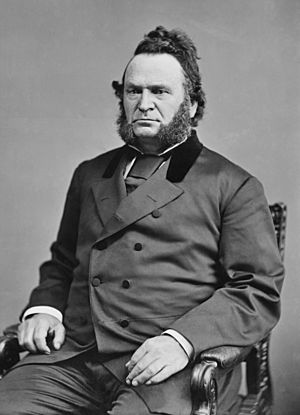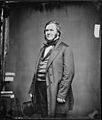James Nesmith facts for kids
Quick facts for kids
James W. Nesmith
|
|
|---|---|
 |
|
| United States Senator from Oregon |
|
| In office March 4, 1861 – March 3, 1867 |
|
| Preceded by | Joseph Lane |
| Succeeded by | Henry W. Corbett |
| Member of the U.S. House of Representatives from Oregon's At-large district |
|
| In office December 1, 1873 – March 3, 1875 |
|
| Preceded by | Joseph G. Wilson |
| Succeeded by | George Augustus La Dow |
| 4th Supreme Judge of the Provisional Government of Oregon | |
| In office December 25, 1844 – August 9, 1845 |
|
| Preceded by | Ira Babcock |
| Succeeded by | Peter Hardeman Burnett |
| Personal details | |
| Born | July 23, 1820 New Brunswick, British Canada |
| Died | June 17, 1885 (aged 64) Rickreall, Oregon |
| Political party | Democratic |
| Profession | Lawyer |
James Willis Nesmith (born July 23, 1820 – died June 17, 1885) was an American politician and lawyer from Oregon. He was born in New Brunswick, which was a British colony at the time. His parents were American. He grew up in New Hampshire and Maine.
Nesmith was a member of the Democratic Party. In 1843, he moved to Oregon Country. There, he became involved in politics. He served as a judge and a lawmaker in the early Provisional Government of Oregon. He also worked as a United States Marshal. After Oregon became a state, he served as a U.S. Senator and a U.S. Representative.
James Nesmith's family also had a history in politics. His grandson, Clifton N. McArthur, and his son-in-law, Levi Ankeny, both later served in the U.S. Congress.
Contents
Early Life and Education
James Nesmith was born on July 23, 1820, in what is now the Canadian province of New Brunswick. At that time, it was a British colony. His parents were visiting from their home in Washington County, Maine. His father was William Morrison Nesmith, and his mother was Harriet Miller. His family had Scottish and Irish roots.
Around 1828, James and his father moved to Claremont, New Hampshire. There, James received some schooling, though it was not extensive. In 1838, Nesmith moved to Ohio. He then moved to Iowa in 1842, planning to travel to Oregon Country. He had planned to go with Elijah White in 1842, but he was late. Instead, he worked as a carpenter in Fort Scott, Kansas, and then left for Oregon the next spring with Marcus Whitman. This journey was along the famous Oregon Trail.
Life and Work in Oregon
In 1843, Nesmith arrived in Oregon. He began to study law and was allowed to practice as a lawyer. In 1845, he was chosen to be the Supreme Judge for the Provisional Government of Oregon. This was the early government before Oregon became a U.S. territory or state. He finished his term in 1846.
After his time as a judge, Nesmith moved to Polk County. He claimed land there and started farming. On June 21, he married Pauline Goff. They had seven children together. In 1847, he was elected to the Provisional Legislature of Oregon from Polk County. He served briefly in 1848 before leaving his position.
Military Service and Other Roles
Nesmith served as a captain in the militia during the Cayuse War from 1847 to 1848. This was a conflict against Native Americans in Eastern Oregon. When people in the Willamette Valley heard about the California Gold Rush in 1848, Nesmith traveled south to the gold fields. He stayed there until 1849.
In 1849, he returned to Polk County. He bought a flour mill on Rickreall Creek near Dallas. Nesmith farmed and raised livestock in this area. The community was even named after him for a time, called Ellendale.
He was again a captain in the militia during the Rogue River Wars in 1853 and the Yakima War in 1855. Between these wars, he served as the United States Marshal for the Oregon Territory. He took over this role from Joseph Meek. From 1857 to 1859, he was the Superintendent of Indian Affairs for the Oregon and Washington Territories. In this role, Nesmith had very strict policies towards Native American tribes.
Serving in Congress
Oregon officially became the 33rd U.S. state on February 14, 1859. In 1860, the Oregon Legislative Assembly elected Nesmith to the United States Senate. As a Democrat, he served from March 4, 1861, to March 3, 1867. He tried to be re-elected but was not successful.
While in the Senate, Nesmith and Reverdy Johnson were the only Democrats to vote for the Thirteenth Amendment to the United States Constitution. This amendment was very important because it abolished slavery in the United States. After his time in the Senate, he was nominated to be a Minister (a type of diplomat) to Austria. However, his nomination was not approved.
After returning to Rickreall, Oregon, he served as a road supervisor for Polk County in 1868. Nesmith was later elected to the Forty-third Congress. He filled a spot that became open after his cousin, Joseph G. Wilson, passed away. He served in the United States House of Representatives from December 1, 1873, to March 3, 1875. He decided not to seek re-election in 1874 and returned to farming in Polk County.
Later Life and Family
James Nesmith had several family members who also became involved in politics. His cousin, Joseph Wilson, and his grandson, Clifton Nesmith McArthur, both served as U.S. Representatives from Oregon. His son-in-law, Levi Ankeny, became a Senator for Washington.
James Willis Nesmith passed away in Rickreall, Oregon, on June 17, 1885. He was 64 years old. He was buried in Polk County on the south bank of Rickreall Creek.
Images for kids




